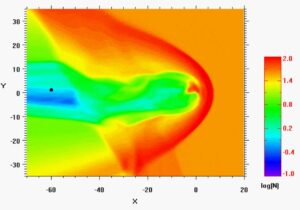
The Earth’s magnetosphere protects the plant from bursts of solar wind — high-speed particles emanating from the sun — and the Moon as well, at least during the 25% of the time when the Earth stands between it and the sun. However, NASA scientists have discovered that solar wind can cause the tail of Earth’s protective magnetic bubble to flap like a windsock in a high breeze, pulling the tail so far out of line that the Moon loses its shelter.
The finding is significant because solar radiation may be the greatest hazard facing explorers and settlers on the Moon, and their equipment, making the ability to predict bursts of radiation a critical necessity.
Summarizing new research in the Journal of Geophysical Research: Space Physics, NASA’s Goddard Space Flight writes in SciTechDaily says that the findings came from compiling data measured by spacecraft at multiple locations in cislunar space and on the Moon. States the article:

Data from the missions showed that the strong wind behind the shock wave pushed aside the magnetosphere’s long trailing tail, causing it to wave back and forth like a windsock. The side-to-side movement was so large that it repeatedly exposed the Moon to the solar wind over a half hour period. This research also showed the lunar exposure could happen even without a shockwave – such as at times when the solar wind blows sideways – suggesting the exposure could occur even more commonly than previously thought.
Refer to the SciTechDaily to view the animated version of the computer simulation.
